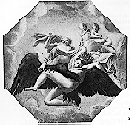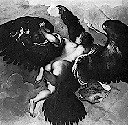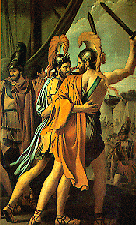 |
History of Homosexuality . . . and Homosexuality in HistoryGuest Curators: Mario DiGangi, Julia Giordano, Department of English and Comparative Literature, Columbia University |
||||
| Cover illustration from Halperin's One Hundred Years of Homosexuality, showing detail of Jose de Madrazo Santander's, The Death of the Spanish Rebel Viriathus, courtesy of the Prado | |||||
The Stonewall riots sparked not only the modern political movement for gay and lesbian liberation, but a wave of publications examining the histories, politics, sexualities, and cultures of lesbian and gay people. Books and journals published in the aftermath of Stonewall dealt directly with the new homosexual politics and with theories of sexual and social revolution. Gay men and lesbians located both within and outside of academia soon began to explore the history of homosexuality in Western societies. Since the late seventies, as the lesbian and gay presence has been increasingly asserted in American universities--at the level of scholarship, teaching, and politics--academic research and publishing on queer history have flourished.
This case represents some highlights of post-Stonewall American scholarship devoted to "reclaiming the gay and lesbian past." All of the books featured here are valuable not only for their contributions to our knowledge about the history of homosexuality , but for a characteristically post-Stonewall open commitment and dedication to lesbian and gay lives, cultures, and politics.
Case Displays
THE 1990s...
Three books published in the early 1990s represent some important theoretical developments in lesbian and gay scholarship. While its historical subject is ancient Greece, Halperin's One Hundred Years of Homosexuality offers an alternative to approaches like John Boswell's that posit the universal existence of "gay people" at all times and in all societies. Instead, Halperin argues that the concept of distinct sexual orientation implied by words like "homosexual" or "gay" developed only in the last hundred years; therefore, these concepts do not describe pre-modern same-sex experiences. Although Eve Kosofsky Sedgwick and Jonathan Goldberg are literary scholars, their books also advanced influential theoretical paradigms for writing the history of homosexuality. Sedgwick's Epistemology of the Closet examines the multiple effects of the modern invention of the conceptual binary "homosexual/ heterosexual." Her challenging interpretation of nineteenth- and twentieth-century literature reveals a continuing tension in the modern West between two contradictory understandings of homosexuality: as a universal potential in all people, or as a minority orientation. Goldberg's Sodometries exposes the contradictory meanings of "sodomy" in a variety of Renaissance literary texts. He carefully distinguishes early modern ideas about sodomy and male homoeroticism from the modern idea "homosexuality," and reminds us that "sodomy" continues to exert a damaging political and legal force in our own society.
 Click for larger |
David Halperin, b. 1952. One Hundred Years of Homosexuality and Other Essays on Greek Love. New York: Routledge, 1990. |
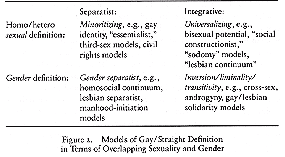 Click for larger |
Eve Kosofsky Sedgwick, 1950-2009. Epistemology of the Closet. Berkeley: University of California Press, 1990. |
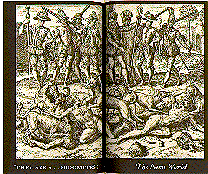 Click for larger |
Jonathan Goldberg. Sodometries: Renaissance Texts, Modern Sexualities. Stanford, Calif.: Stanford University Press, 1992. |
This sixteenth-century illustration reveals the violence of a European encounter with "New World" inhabitants. In 1513, Balboa fed to his dogs forty Panamanian Indians accused of sodomy, a common charge against native peoples.
THE MID/LATE 1980s...
During the mid and late 1980s, gay and lesbian historical scholarship broadened in diversity, depth of focus, and theoretical sophistication. John D'Emilio traced the developments leading up to Stonewall-era activism in Sexual Politics, Sexual Communities, a pioneering exploration of the American homophile movements since 1940. James Saslow's Ganymede in the Renaissance is not only a model work of scholarship in the field of art history, but the first book on homosexuality in Renaissance Europe by an American scholar. Both D'Emilio's and Saslow's books began as Columbia University dissertations. The important anthology Hidden from History made available twenty-nine rich and varied essays dealing with lesbian and gay experiences since ancient times in several cultures (not only in the United States and Europe, but Asia, Africa, and Cuba). This book dramatically represents the diversity of approaches and the diversity of topics comprising lesbian and gay history.
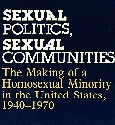 Click for larger |
John D'Emilio, b. 1948. Sexual Politics, Sexual Communities: The Making of a Homosexual Minority in the United States, 1940-1970. Chicago: University of Chicago Press, 1983. |
 Click for larger |
Martin Duberman et al, editors. Hidden From History: Reclaiming the Gay and Lesbian Past. New York: NAL Books, 1989. These nineteenth-century American women cross dressed and "passed" as men for many years. Cora Anderson, a native American, was arrested in 1914 for disorderly conduct; Lillie Hitchcock Coit escaped arrest because she was wealthy. |
LATE 1970s / EARLY 1980s...
With Gay American History, Jonathan Ned Katz published the first book of documents relating to homosexuality in American history. This fascinating and compendious source ranges from the sixteenth century up to present times; its texts include everything from denunciations of sodomy in colonial America to modern protests against homosexual persecution. Comparable in its historical scope is Lillian Faderman's Surpassing the Love of Men, which examines the history of romantic friendship between women from the sixteenth to the twentieth centuries. Focusing on the changing status of male-male love from the late classical era to the middle ages, John Boswell's groundbreaking Christianity, Social Tolerance, and Homosexuality finds gay people and gay subcultures even further back in history. By demonstrating the important presence of same-sex desires, friendships, and sexual practices throughout Western history, these books were crucial in opening up new fields for investigation.
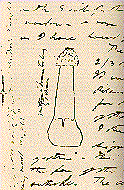 Click for larger |
Jonathan Katz. Gay American History: Lesbians and Gay Men in the U.S.A. New York: Crowell, 1976 Katz uses this illustration drawn by Henry David Thoreau of "Phallus impudicus" (the shameless phallus), among excerpts from Thoreau's letters about his re action after reading Whitman's Leaves of Grass: "It is as if the beasts spoke. I think that men have not been ashamed of themselves without reason." |
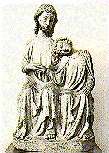 Click for larger |
John Boswell. Christianity, Social Tolerance, and Homosexuality: Gay People in Western Europe from the Beginning of the Christian Era to the Fourteenth Century. Chicago: University of Chicago Press, 1980. Boswell uses this fourteenth-century sculpture of an older Christ with the youthful Saint John as an example of what he calls "the tradition of passionate friendship common among the monastic clergy of the Middle Ages." |
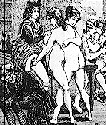  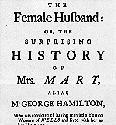 |
Lillian Faderman. Surpassing the Love of Men: Romantic Friendship and Love Between Women from the Renaissance to the Present. New York: Morrow, 1981. |
| Click above for larger |
These illustrations document some examples of the
persistent fascination with the transvestite woman who seduces another
women and what Faderman calls "fears about women who refused to be simply
feminine." The first illustration above is from The Memoirs of Casanova. Illustration
by Chauvet. This is from a late nineteenth-century privately printed
edition of this eighteenth-century work. The second is a woodcut of
Deborah Sampson, a soldier of the American Revolution. The caption states
"In Deborah Sampson's case, the lass who loved a soldier had a rude
awakening." The third is the title page of The Female Husband (1746) by Henry Fielding.
